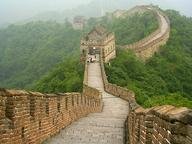Quiz Answer Key and Fun Facts
1. China's third largest city (after Shanghai and Beijing) and home to the world's tallest tower (pictured) in 2010, Guangzhou is located on the Pearl River about 75 miles north of Hong Kong. By what name was Guangzhou known to English speakers since the 17th Century?
2. The largest direct-controlled municipality in China and the capital of the Republic of China during the 1937-45 Sino-Japanese War, which city of about 32 million is the economic centre of the upstream Yangtze basin region?
3. China's fourth-largest city, and the largest coastal city in northern China, this city is home to one of the world's largest Ferris wheels (pictured). Which city is this that stands 75 miles northwest of Beijing on the coast of the Bohai Gulf, an inlet of the Yellow Sea?
4. Founded more than 3,100 years ago, one of China's oldest cities was known as Chang'an before the Ming dynasty (1368-1644). One of China's most popular tourist destinations, where would you come to see the Mausoleum of Qin Shi Huang and his Terracotta Army?
5. The picture shows "Tiger Hill Pagoda", a 154-foot high tower that was completed in 961 and is now dubbed "The Leaning Tower of China". It is located in which 2,500-year old city that was once the world's largest non-capital?
6. The capital of Sichuan province, China's most populous prefecture-level city is home to 7.1 million with a further 6.7 million living in the surrounding region (2010). Sichuan is also home to 80% of the world's wild giant pandas and the world's only breeding center located in a metropolitan area can be found here. Which city, nicknamed "The City of Hibiscus" are we visiting?
7. This city of 3.7 million is a seaport on China's northeastern coast whose name means 'green island'. It stands at the eastern end of the world's longest bridge over water, stretching more than 25 miles across Jiaozhou Bay. Which city is this, where the central square is dominated by this impressive Wuyue Feng sculpture (pictured)?
8. An ancient city dating back to 1,500 B.C., it is now home to more than 7.2 million and is the most populous city in Central China. Its most famous native is tennis player Li Na, the first Asian player ever to win a grand slam event. The 3rd century A.D. "Yellow Crane Tower" (pictured), stands on Snake Hill beside the Yangtze River, overlooking which city?
9. Formerly called Mukden, the capital of Liaoning province and the largest city in northeast China was conquered by the Manchu people and briefly became the capital in the early years of the Qing dynasty (1644-1912). In Zhongshan Square in the city centre is one of China's largest statues of Mao Zedong (pictured), and one of the few not removed in recent years. Which city are we visiting?
10. The "City of Springs" is home to more than seventy natural artesian springs, the most famous of which is "Five Dragon Pool" (pictured). Home to 4.3 million, which city is this, the capital of Shandong province in eastern China?
Source: Author
EnglishJedi
This quiz was reviewed by FunTrivia editor
Tizzabelle before going online.
Any errors found in FunTrivia content are routinely corrected through our feedback system.

